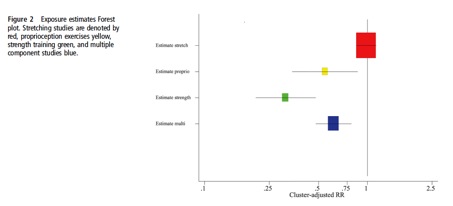Letter to the Editor
By Dr. Babette Pluim (@DocPluim)
In response to: , , Lars Bo Andersen.
Strength training was the big winner in a recent BJSM systematic review and meta-analysis of Lauersen et al.1 The authors carefully quantified the preventive effect of several different forms of physical activity programs. They differentiated between the effect on acute and overuse injuries. Previous studies on musculoskeletal injuries, have focused on one particular intervention, one injury type or location, one specific sport, or were narrative reviews. This is a quantum step forward.
The field is relatively mature with 25 RCTs to study, including 26 610 participants with 3464 injuries. The studies were grouped into strength exercises, stretching exercises, proprioception exercises and multiple exposure studies.
Strength training was the most effective intervention and reduced sports injuries to less than one third (RR 0.315 (0.207-0.480). Proprioception exercises were also effective and reduced the number to almost half (RR 0.550 (0.347-0.869). Contrary to my expectations multiple exposure interventions were less effective (RR 0.655 (0.520-0.286) and stretching had no beneficial effect at all (RR 0.963 (0.846-1.095). Outcome analysis showed that both acute (RR 0.647 (0.502-0.836) and overuse injuries (RR 0.527 (0.373-0.746) could be reduced by preventative exercise programs.
Clinical implications
1. There is great potential in strength training — we should utilize this more. The results from the strength training studies were consistent, despite different programmes being used and despite different outcomes of interest, which points towards a strong generalisability of results. This means that many types of strength exercise have the potential to prevent many types of injuries.
2. Was it a nail in the coffin for stretching exercises? Stretching did not prevent injuries, whether done before or after training. However, this analysis included only two studies on army recruits and one internet-based study on the general population, so more data are badly wanted.2-4 Stretching may serve other purposes, and it may still be relevant for the upper extremity, but NOT for injury prevention of lower extremity exercises. It may be helpful in specific cases if there has been a previous injury. But today, there is no evidence supporting stretching for injury prevention.
It makes intuitive sense to combine several interventions to prevent all injuries, and I was therefore surprised that see that multiple intervention studies had smaller effect size that strength training or proprioception alone. However, the authors point out that each component may be reduced quantitatively or qualitatively by designing a program with an array of exposures (the proportion of effective interventions may be smaller, compliance may suffer etc). They therefore suggest these type of programs should be built from well-proven single exposures and they stress the importance of further research into single exposures.
The take home message for me as a sports physician is that I will take strengthening exercises to prevent injuries even more seriously than I already did:
– hip abduction, lunges, squats, step ups and step downs to prevent ACL injuries and anterior knee pain
– leg curls and Nordic hamstring exercise to prevent hamstring injuries
– proprioception exercises for the ankle (the ankle app!)5 to prevent ankle injuries
The recent data of Clarsen et al. on the shoulder are promising,6 and as a tennis doctor, I would love to see an RCT on the effect of external rotator cuff strengthening as a follow up to their cohort study :-).
*********************************************************
Dr Babette Pluim is a Sports Physician with particular expertise in Tennis Medicine (Chief Medical officer – Netherlands. She is Deputy Editor of BJSM. Follow her on twitter @DocPluim
References
1. Lauersen JB, Bertelsen DM, Andersen LB. The effectiveness of exercise interventions to prevent sports injuries: a systematic review and meta-analysis of randomised controlled trials. Br J Sports Med 2014:48:871-7.
2. Jamtvedt G, Herbert RD, Flottorp S, et al. A pragmatic randomised trial of stretching before and after physical activity to prevent injury and soreness. Br J Sports Med 2010;44:1002–9. LaBella CR, Huxford
3. Pope R, Herbert R, Kirwan J. Effects of ankle dorsiflexion range and pre-exercise calf muscle stretching on injury risk in Army recruits. Aust J Physiother 1998;44:65–72.
4. Pope RP, Herbert RD, Kirwan JD, et al. A randomized trial of preexercise stretching for prevention of lower-limb injury. Med Sci Sports Exerc 2000;32:271–7.
5. Verhagen E. Easy to use mobile app for ankle sprains prevention and rehabilitation. https://blogs.bmj.com/bjsm/2014/04/07/easy-to-use-mobile-app-for-ankle-sprains-prevention-and-rehabilitation/
6. Clarsen B, Bahr R, Andersson SH, et al. Reduced glenohumeral rotation, external rotation weakness and scapular dyskinesis are risk factors for shoulder injuries among elite male handball players: a prospective cohort study. Br J Sports Med 2014. Published Online First 19 June 2014.
